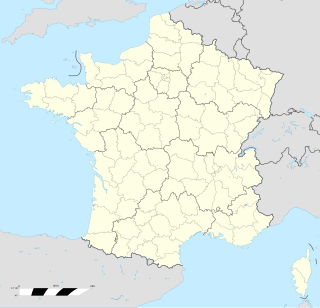The title Baron Bergavenny was created several times in the Peerage of England and once in the Peerage of Great Britain, all but the first being baronies created by error.

William de Cantilupe was feudal baron of Eaton Bray in Bedfordshire, and jure uxoris was feudal baron of Totnes in Devon and Lord of Abergavenny. His chief residences were at Calne in Wiltshire and Aston Cantlow, in Warwickshire, until he inherited Abergavenny Castle and the other estates of that lordship.

Aston Cantlow is a village in Warwickshire, England, on the River Alne 5 miles (8.0 km) north-west of Stratford and 2 miles (3.2 km) north-west of Wilmcote, close to Little Alne, Shelfield, and Newnham. It was the home of Mary Arden, Shakespeare's mother. At the 2001 census, it had a population of 1,674, being measured again as 437 at the 2011 Census.

Abergavenny Castle is a ruined castle in the market town of Abergavenny, Monmouthshire, Wales, established by the Norman lord Hamelin de Balun in about 1087. It was the site of a massacre of Welsh noblemen in 1175, and was attacked during the early 15th century Glyndŵr Rising. William Camden, the 16th century antiquary, said that the castle "has been oftner stain'd with the infamy of treachery, than any other castle in Wales."

Wilton Castle is a 12th-century Norman castle located in south-eastern Herefordshire, England on the River Wye adjacent to the town of Ross-on-Wye. The castle is named after the manor associated with it.

John Hastings, 1st Baron Hastings was an English peer and soldier of the Middle Ages. Hastings was a competitor for the Scottish throne in 1290/92 in the Great Cause.

Hamelin de Ballon, (b ca. 1060, died 5 March 1105/6, was an early Norman Baron and the first Baron Abergavenny and Lord of Over Gwent and Abergavenny; he also served William Rufus.

The Priory Church of St Mary, Abergavenny is a parish church in the centre of Abergavenny in Monmouthshire, Wales.
Hugh de Beauchamp was an Anglo-Norman feudal lord of Abergavenny in the Welsh Marches in the late 12th century.

The House of Braose was a prominent family of Anglo-Norman nobles originating in Briouze, near Argentan, Orne, Normandy. Members of this family played a significant part in the Norman conquest of England and subsequent power struggles in England, Wales and Ireland in the 11th to 14th centuries.

Jessant-de-lys is a heraldic term denoting a fleur-de-lys issuing out of any object. It is most frequently seen in conjunction with a leopard's face, meaning in heraldic language the face of a lion.
Henry de Longchamp or Henry de Longo Campo (c1150–1212) was an Anglo-Norman administrator.

William de Cantilupe was an Anglo-Norman baron and royal administrator.

William de Cantilupe was an Anglo-Norman magnate.
William de Cantilupe may refer to:

Eva de Braose was one of the four co-heiresses of William de Braose. She was the wife of William de Cantilupe who, as a result of his marriage, acquired significant land holdings in both England and Wales.
The manor of Broad Hempston was an historic manor situated in Devon, England, about 4 miles north of Totnes. The present village known as Broadhempston was the chief settlement within the manor and remains the location of the ancient parish church of St Peter and St Paul.
This page is based on this
Wikipedia article Text is available under the
CC BY-SA 4.0 license; additional terms may apply.
Images, videos and audio are available under their respective licenses.












